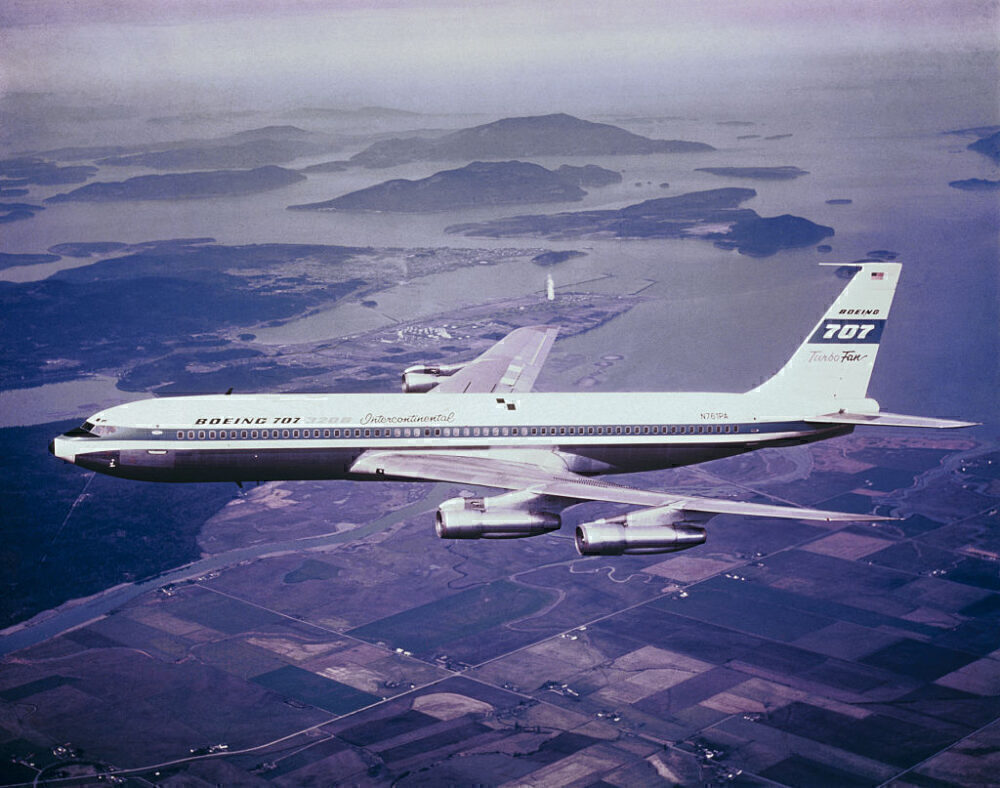The Boeing 720 is an anomaly among Boeing’s commercial jets. With the United States-based aircraft manufacturer favoring a number system that starts and ends with seven, a name that ends with zero sticks out. So, why did the company choose to name the plane this way? Let’s take a look into the journey of how the jet and its title came about.

Putting a structured system in place
After World War II, Boeing was a military airplane enterprise. However, William Allen, Boeing’s president at the time, felt it was time to venture back into the commercial realm. However, it still wanted to make progress in other aspects such as with missiles and spacecraft.
So, amid this diversification of products, the company’s engineering team segmented model numbers into blocks of 100 for each of the departments. 300 and 400 were implemented for commercial propeller-driven planes while 500 was introduced for turbo-engines. Subsequently, Boeing used 600 for missiles and rocket-powered devices.
The firm developed the first large swept-wing jet in the world with the B-47. Even though this plane was a military legend, airlines also showed their interest in the model. Notably, Pan Am asked Boeing to look into the prospects of applying the aircraft as a commercial jet. Meanwhile, the manufacturer was also studying the conversion of the propeller-driven model 367 Stratotanker, which is better known as the KC-97, into a jet-powered tanker that would keep up with the B-52 during inflight refueling.

The jet age
The development team went through several editions of the model 367 before settling on a variant numbered 367-80. This model would go by the moniker of Dash 80. the aircraft would mark the transition into the familiar Boeing numbering system that we are all familiar with – the 7-7 formula. This factor would also contribute to the eventual naming of the 720.
“Boeing took a calculated risk by financing the development and construction of the Dash 80 prototype with its own funds. The goal was to put the airplane into production as both an Air Force tanker/transport and a commercial jet transport. Since both of these offspring of the Dash 80 would be jet transports, the model number system called for a number in the 700s to identify the two new planes. The marketing department decided that “Model 700” did not have a good ring to it for the company’s first commercial jet. So they decided to skip ahead to Model 707 because that reiteration seemed a bit catchier,” Boeing Frontiers explains.
“Following that pattern, the other offspring of the Dash 80, the Air Force tanker, was given the model number 717. Since it was an Air Force plane, it was also given a military designation of KC-135. After 717 was assigned to the KC-135, the marketing department made the decision that all remaining model numbers that began and or ended in 7 would be reserved exclusively for commercial jets. (After the Boeing-McDonnell Douglas merger in the late 1990s, the model number 717 was reused to identify the MD-95 as part of the Boeing commercial jet family.”

Taking on the industry
The Boeing 707 was introduced with Pan Am in October 1958, setting the standard for Boeing’s commercial jets in the decades that followed. In only a few years, air surpassed rail and sea travel with the assistance of this plane.
Stay informed: Sign up for our daily and weekly aviation news digests!
Boeing was happy to modify the type to suit the needs of its clients. It built rare long-range customizations for Qantas and even installed larger engines for Braniff for when the airline went to high altitudes in Latin America.
One of these modifications was the 720. The plane was designated this number when it was modified to take on short- to medium-range operations and for use on shorter runways. This variant had its fuselage length shortened by 9 feet (2.7 meters). Along with this, its leading edge flaps were switched before turbofan engines were equipped.

Taking care of the customers
In hindsight, there was a noticeable oddity to the Boeing commercial jet numbering process with the 720. The plane was actually first promoted to carriers as the model 707-020. United Airlines was significantly keen on taking on this model. However, it had previously decided to go with Douglas’ DC-8. So, to help save face and help the Chicago-based carrier avoid any negative public relations for reverting to the 707, Boeing Frontiers explains that the planemaker changed the entire name. Thus, the 720 was born.
The 720 made its first flight on November 23rd, 1959, and was subsequently introduced on July 5th, 1960. In total, 154 units were built between 1958 and 1967. Notably, United was the first carrier to fly the plane. Therefore, the tailored approach with the 707 range paid off for Boeing. Together, the 707 and the 720 overtook the DC-8 when it came to purchases.

A successful series
Altogether, all Boeing jets apart from the 720 were named in succession based on the 7-7 formula. The 707, 717, 727, 737, 747, 757, and 777 have all gone by this code. Even the latest commercial jet, the 787 carried on the trend.
Simple Flying recently noted that if Boeing wants to continue the 7-7 formula, presently, the only number free is 797. This model has long been rumored to be a new middle-market plane. Eventually, the company may choose to add a fourth number to the mix, as it did with the proposed Boeing 2707 Super Sonic Transport (SST), which was billed to be the United States’ answer to Europe’s Concorde.
Overall, what are your thoughts about the reason why Boeing named the aircraft the 720? Do you feel that this was a good move by the company? Let us know what you think of the decision in the comment section.
[ad_2]
Source link


